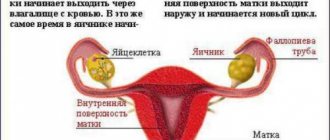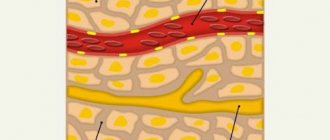Menstrual irregularities
Iron deficiency
Menopause
Climax
Uterine cancer
Cervical cancer
15266 02 February
IMPORTANT!
The information in this section cannot be used for self-diagnosis and self-treatment.
In case of pain or other exacerbation of the disease, diagnostic tests should be prescribed only by the attending physician. To make a diagnosis and properly prescribe treatment, you should contact your doctor. Menstrual irregularities: causes of occurrence, what diseases cause them, diagnosis and treatment methods.
Definition
Menstrual cycle disorders (MCI) are not a pathology, but only a symptom of problems in the female body. A physiologically normal manifestation of the ongoing ovarian-menstrual cycle is the occurrence of menstruation with an individual frequency and duration for each woman. Menstruation is the name given to repeated uterine bleeding, during which an unfertilized egg, endometrial particles and mucous secretions from the cervix are released from the body along with menstrual blood. Normally, they are not accompanied by significant blood loss due to rapid contraction of blood vessels, and their volume is about 150 ml.
The menstrual cycle is not only menstruation, but also the maturation of the egg in the ovary, ovulation and the growth of the endometrium for the potential introduction of a fertilized egg into it.
A healthy woman of reproductive age may experience anovulatory menstrual cycles, during which fertilization does not occur due to the lack of release of the egg. With age, the number of such cycles increases.
Menarche (first menstruation) usually develops by the age of 11-15 and indicates the readiness of the woman’s reproductive system for fertilization. The time at which menarche appears varies from person to person and depends on many factors, such as weight, diet with sufficient fat, heredity, etc.
Types of menstrual irregularities
The menstrual cycle depends on the coordinated functioning of the endocrine system, so the most common cause of its disorders is hormonal imbalance.
- Disorders associated with pathology of the brain (hypothalamic-pituitary structures), which entail a failure of the neuroendocrine regulation of sexual function.
- Pathology of the uterus and/or ovaries.
- Congenital pathologies, including chromosomal ones.
- Diseases of other endocrine organs, for example, hypo- and hyperthyroidism.
Menstrual irregularities after 40 years of age may be associated with the decline of the reproductive function of the female body, while the amount of estrogen naturally decreases, the number of anovulatory cycles increases, and dysfunctional uterine bleeding may occur.
The unevenness of the menstrual cycle in girls of puberty is explained both by the incomplete formation of the reproductive system and by the widespread obsession with diets at this age, in which the body does not receive enough fats necessary for the synthesis of sex hormones.
Symptoms of menstrual irregularities
:
- Changing the duration of the cycle towards decreasing (less than 21 days) or increasing (more than 35 days).
- Delayed menstruation with normal frequency of previous ones.
- Amenorrhea is the absence of menstruation in a woman of reproductive age for more than 6 months (can be primary and secondary; secondary is typical for girls of puberty).
- Change in the volume of menstrual blood loss towards increase or decrease.
- Change in the duration of menstruation towards a decrease or increase.
- The appearance of intermenstrual discharge of varying degrees of severity.
- Clinically pronounced pain syndrome (algomenorrhea, algomenorrhea).
With an increase in the volume and duration of menstrual bleeding and the appearance of acyclic bleeding, there is a risk of developing iron deficiency anemia.
For many women, infertility is associated with menstrual irregularities - the absence of pregnancy within 1 year of regular sexual activity without the use of contraception. At the same time, the presence of anovulatory cycles often does not manifest itself in anything other than the absence of conception, so the woman considers herself reproductively healthy.
Menstrual cycle disorders at different age periods of a woman’s life
Juvenile period (up to 21 years). Characterized by delayed menstruation, pubertal bleeding, hair loss, insufficiency or excess body weight. Stress and changes in the sleep-wake cycle can be a provoking factor.
Reproductive period (up to 45–50 years). It is necessary to distinguish between pathological causes of menstrual irregularities and physiological ones.
Physiological reasons include changes in the menstrual cycle due to pregnancy, breastfeeding, and the use of intrauterine contraceptives.
One of the common pathological causes is the formation of a follicular cyst: the egg is not fertilized, excessive growth of the follicle is noted, which leads to the growth of the endometrium. This process can last up to 6–8 weeks, resembling the development of pregnancy, but then heavy menstruation follows, which is dysfunctional uterine bleeding. Pathological bleeding can develop during the ovulatory period, which is associated with insufficiency of the luteal phase (that is, hormonal imbalance). Increased changes in the menstrual cycle should be expected after an abortion (spontaneous (miscarriage) or medical, including medicinal). Restoring the menstrual cycle usually takes about three months; if there are complications, the process becomes protracted.
Menopause and premenopause. During premenopause, changes in hormonal levels in conditions of declining reproductive function lead to disruption of cyclicity and heavy menstruation. In addition, women complain of unexplained mood swings and autonomic disorders (the so-called menopausal syndrome).
Uterine bleeding during menopause is an alarming symptom and requires immediate medical attention.
Pregnancy with an irregular menstrual cycle is possible, but its occurrence depends on the severity of the disorder. Often, menstrual irregularities lead to spontaneous abortion in the early stages.
Which doctors should I contact if I have menstrual irregularities?
Any irregularity in the menstrual cycle requires contacting a gynecologist. In most cases, these disorders have a favorable outcome, but about 10% are gynecological cancers. If necessary, the gynecologist can prescribe a consultation with an endocrinologist.
Diagnosis of menstrual cycle disorders
The leading role in the diagnostic search is played by collecting anamnesis with the obligatory clarification of many factors: the presence of pregnancies and the characteristics of their course, methods of contraception, previous diseases, surgical interventions, determination of body mass index.
To exclude inflammatory diseases of the pelvic organs, most often caused by infections such as gonococcus, genital herpes, ureaplasma, mycoplasma, chlamydia, gardnerella, spirochete pallidum, trichomonas, cytomegalovirus, a smear is taken on the microflora to determine the sensitivity of the pathogen to antimicrobial drugs.
Why do I have frequent periods?
The hormones estrogen and progesterone are responsible for the regularity of menstruation. The ovaries, pituitary gland, and hypothalamus are responsible for maintaining their balance.
Polymenorrhea or frequent menstruation occurs due to a disruption of normal hormonal levels, the causes of which are the following:
- Inflammatory diseases of the reproductive system – endometritis, adnexitis, salpingoophoritis.
- Sexually transmitted infectious diseases.
- Endometriosis.
- Formations in the organs of the reproductive system - uterine fibroids, ovarian cysts, polyps.
- Use of oral contraception.
- Diseases of other organs - pathologies of the thyroid gland, diabetes mellitus, problems with the liver.
- Lifestyle changes.
It is impossible to independently identify and eliminate the cause of polymenorrhea. To do this, you need to see a doctor and undergo an examination.
In teenagers
The cycle of girls after menstruation immediately becomes regular in only 30%. For others, it takes up to 2 years for menstruation to normalize. During this period, periods are irregular and may occur more often or less frequently than once every 21–35 days.
A common disorder in teenage girls is juvenile bleeding. Pathology requires treatment.
Hormonal changes
Polymenorrhea is often a consequence of hormonal imbalance in the body.
Imbalance can be caused by natural causes at different ages:
- In teenagers, when the cycle is not yet stable.
- In women after 45 years of age, when perimenopause begins.
Hormonal imbalance causes ovarian dysfunction, its symptoms:
- delay or, conversely, frequent discharge;
- pain in the lower abdomen;
- vivid manifestations of PMS - premenstrual syndrome.
Onset of pregnancy
Sometimes periods appear earlier than expected as a result of conception. This is implantation bleeding, which a woman mistakes for menstruation.
The fertilized egg transforms into a zygote and begins its movement through the tube to the uterine cavity. There it attaches to the wall of the uterus, damaging the smallest blood vessels. This is how minor bleeding due to implantation begins, which occurs in approximately 10% of women.
Another course of events during conception is the rejection of the fertilized egg and its release with bloody discharge.
After childbirth
It takes time for periods to normalize. After childbirth, they may occur too often or, conversely, rarely.
Regular menstruation will occur after 2–3 cycles if the woman does not breastfeed.
Ectopic pregnancy
This is a pathology in which the embryo was unable to reach the uterine cavity and implanted in another place not intended for this purpose. An ectopic pregnancy can be ovarian, tubal, or abdominal.
When the embryo reaches a certain size, it ruptures the organ where it is localized, for example, a pipe. A woman may mistake the beginning of bleeding for painful periods ahead of schedule.
The difference is that with ectopic pregnancy, the stomach does not just hurt, but a severe pain syndrome occurs, accompanied by nausea and vomiting, chills, confusion, and dizziness. The condition requires immediate medical attention.
Inflammatory and infectious diseases
The regularity of the menstrual cycle is affected by inflammatory processes in the reproductive system.
Adnexitis, endometritis, salpingoophoritis cause not only polymenorrhea, but also associated symptoms:
- vaginal discharge – white, yellow-green, cloudy, with an unpleasant odor;
- pain in the lower abdomen, radiating to the lower back, rectum;
- burning, itching, vaginal hyperemia.
Frequent periods provoke sexually transmitted infections of the pelvic organs. Menstruation may look like a brown spot, not only come frequently, but also last up to two weeks.
Uterine fibroids and ovarian cyst
Benign tumors disrupt the functioning of the organ. Myomatous nodes, single or multiple, change the shape of the uterus and the functioning of its muscular layer. For this reason, periods may occur more often than usual.
Cysts formed on the ovaries change hormonal levels. Violation of hormone synthesis reduces or increases the interval between menstruation.
Endometriosis
Pathological growth of the inner layer of the uterus beyond its limits causes intermenstrual bleeding - heavy, with clots.
The spread of the endometrium increases its area. Accordingly, tissue rejection due to endometriosis during menstruation results in heavy bleeding.
Taking oral contraceptives
Birth control pills contain hormones. At the beginning of their use, cycle disruption is possible. Menstrual-like bleeding often begins in the middle of the cycle or begins to occur more often than usual.
This is a normal situation, after 2-3 months the discharge will become regular. This is how the body adapts to the supply of hormones from the outside.
Intrauterine device
A woman’s body often perceives an IUD as a foreign body. The consequence is an inflammatory process in the uterine cavity and premature rejection of the endometrium.
If, after two or three cycles, menstruation has not improved, the intrauterine device should be replaced with another method of contraception.
Lifestyle change
The menstrual cycle is influenced by various factors. Frequent menstruation can be caused by:
- chronic fatigue and overwork;
- suffered stress;
- lack of sleep;
- poor nutrition;
- physical overload;
- flights and climate change.
Video about dysfunctional bleeding
Norm and pathology
So what is the norm and deviations?
The menstrual cycle for each individual woman has its own duration (within 21–35 days). Moreover, the main thing is the regularity in the duration of the cycle itself, and if one time you have it for 21 days, the second 30, the third 33 – then this is already a deviation.
The duration of menstruation ranges from 2 to 8 days, and this is normal. Blood loss per day ranges from 20 to 80 ml (one to four tablespoons).
The most unstable and least predictable cycle is observed within a year from the beginning of menstruation, several years before menopause and after childbirth. But for the rest of the period, a woman should have a stable cycle - a sign of normal functioning of the reproductive system.
It is very important to know that prolonged, more than 8 days, and excessively heavy periods, when you need to change pads and tampons every hour, are not normal and a reason to consult a doctor.
Is treatment necessary?
To find out why the discharge occurs frequently, you should go to the clinic and undergo an examination. If a woman keeps a menstrual calendar, it is better to take it to the appointment, so the doctor can see changes in the cycle.
Frequent periods are not a disease, but the body’s reaction to problems in it. To identify diseases, you need:
- gynecological examination;
- general blood analysis;
- vaginal smear;
- blood test for hormones (if necessary).
The gynecologist can refer you for additional consultation to other specialists - mammologist, endocrinologist.
Treatment tactics depend on the cause. For inflammatory diseases, antibacterial drugs and vitamins are prescribed; for endometriosis, fibroids, and cysts, hormonal therapy is required.
If premature periods were sporadic and come on time in subsequent cycles, the failure may have been caused by stress or lack of sleep. Rest, sleep patterns, and sedatives will restore the body’s functioning.
We recommend reading the article about the reasons for short periods. From it you will learn about the causes of short menstruation in adolescents, during pregnancy, in women after childbirth, at the onset of menopause, as well as the need to consult a doctor.
Why do I have pink discharge a week before my period? Read here.
Alarm Signals
Pain and heavy menstruation
A symptom such as pain is a very good reason to seek qualified help. Especially if the pain appeared suddenly and intensified. Pain can be either temporary discomfort and a tendency to vascular spasms, or a sign of serious disorders that are best identified in the early stages.
Heavy periods with clots and a change in the color of the discharge to a brighter color
A small number of clots can be considered a normal variant. Basically, these are particles of endometrium and mucus. But if there is severe pain, a change in color from dark red to scarlet, and the number of clots exceeds a quarter of the volume of discharge, this is a reason for examination.
Nausea, vomiting and severe headaches, even leading to fainting
Weakness, migraines, dizziness are not a normal condition and are most likely signs of dysmenorrhea, which is a disease. To identify the causes, you need to donate blood for hormones. Dysmenorrhea responds well to treatment with COCs (combined oral contraceptives).
Duration of menstruation is more than 8 days
If your cycle has always been this long, then this is simply the characteristics of your body. But if the duration begins to increase over time, this is a cause for alarm. An increase in blood volume should also alert you. If the amount of discharge is more than 4 tablespoons per day, and there is a need to change the pad at night, this is a clear reason for examination. All these symptoms can lead to anemia and oxygen starvation of the entire body.
Spotting between cycles
May be signs of a polyp, infection, pelvic inflammation. If these are isolated cases, then they are most likely caused by stress, moving, or climate change. In case of systematic spotting outside the cycle, you need to consult a gynecologist.
Heavy periods after childbirth
May be caused by uterine hypotension, retained part of the placenta, or infection. The postpartum period is very difficult for a woman’s body. You need to listen to your condition and if you are worried, consult your doctor immediately.
Heavy periods and especially heavy periods with clots after menopause
These are signs of menopausal bleeding; you need to immediately seek qualified help.
Causes of heavy periods
- endometriosis and endometritis;
- blood diseases such as purpura, hemophilia and others;
- polycystic ovary syndrome;
- adenomyosis, uterine fibroids;
- problems with the thyroid gland;
- polyps of the cavity or cervix, fibrous tumors;
- hormonal imbalance;
- spontaneous abortion and ectopic pregnancy;
- taking certain medications (aspirin, warfarin, willow bark);
- recent childbirth and surgical procedures;
- infections;
- failure of the ovaries, ovulation disorders;
- intrauterine device;
- high sports loads.










